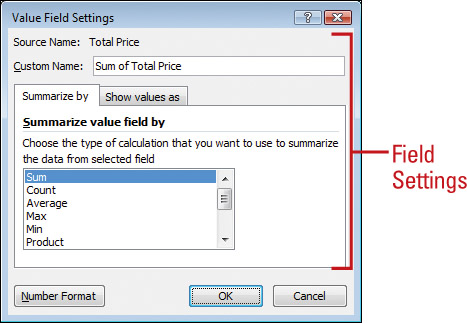Modifying a PivotTable
You
can use the Options tab under PivotTable Tools to modify a PivotTable
to summarize, organize, and display the information you want to present.
Many of the options—Group, Sort, Clear, Select, or Move—are similar to
the ones available for Excel tables and charts. You can use the Options
button to change PivotTable layout, format, totals, filter, display,
printing and data settings. Use the Field Setting button to change field
layout, print, subtotals, and filter settings.
Modify a PivotTable Report
 Click any field in the PivotTable report.
Click any field in the PivotTable report.
 Click the Options tab under PivotTable Tools.
Click the Options tab under PivotTable Tools.
 To change PivotTable options, click the Options button, make the changes you want, and then click OK.
To change PivotTable options, click the Options button, make the changes you want, and then click OK.
 To change field settings, select the field you want to change, click the Field Settings button, make the changes you want, and then click OK.
To change field settings, select the field you want to change, click the Field Settings button, make the changes you want, and then click OK.
 Use any of the following options to change the PivotTable:
Use any of the following options to change the PivotTable:
- Group Selection, Ungroup, or Group Field. Use to group, ungroup PivotTable elements or fields.
- Sort & Filter. Use to sort or filter fields in a PivotTable.
- Clear. Use to clear filters, labels, values, and formatting.
- Select. Use to select PivotTable elements.
- Calculations. Use to insert calculated fields and items, change solve order, and list formulas (New!).
- Field List. Show or hide the Field List.
- Buttons. Show or hide group +/- buttons.
- Field Headers. Show or hide field headers for columns and rows.


Formatting a PivotTable
After
you create a PivotTable, you can use formatting tools on the Design tab
under PivotTable Tools to modify the look and feel of a PivotTable.
Formatting a PivotTable can be quick and easy with PivotTable Quick
Styles. When you create a PivotTable, Excel displays a standard set of
elements, including headings, columns, and rows. You can select or clear
options on the Design tab to quickly format a PivotTable the way you
want. Layout buttons, such as Subtotals, Grand Totals, Report Layout,
and Blank Row, give you additional options to show or hide PivotTable
elements.
Format a PivotTable Report
 Click any field in the PivotTable report.
Click any field in the PivotTable report.
 Click the Design tab under PivotTable Tools.
Click the Design tab under PivotTable Tools.
 Click the More list arrow under PivotTable Styles, and then click the PivotTable style you want.
Click the More list arrow under PivotTable Styles, and then click the PivotTable style you want.
 Select or clear the PivotTable format options you want to turn on or off:
Select or clear the PivotTable format options you want to turn on or off:
- Row Headers.
- Column Headers.
- Banded Rows.
- Banded Columns.
 Click any of the following layout buttons to select options to show or hide PivotTable elements:
Click any of the following layout buttons to select options to show or hide PivotTable elements:
- Subtotals. Show or hide subtotals.
- Grand Totals. Turn on or off grand totals for columns or rows.
- Report Layout. Set to compact, outline, or tabular form.
- Blank Row. Insert or remove a blank line after each item.
